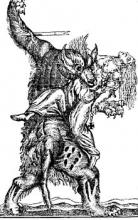A werewolf is a man who turns into a furry half-wolf, half-man at the full moon after being bitten by another werewolf, right? According to Hollywood, yes. According to any traditional werewolf folklore, no.
In werewolf folklore, a werewolf can be one of a few things. An outlaw or warrior dressed in a wolf's skin, according to the ancient Saxons and Vikings. A serial killer showing “wolfish” qualities- medieval people often interpreted what we would call serial killers as being werewolves. A sorcerer capable of sending his spirit out of his body in the shape of a wolf. A witch who uses an herbal hallucinogenic ointment to induce visions of shapeshifting into wolf form. A sub-type of vampire, according to Eastern European lore. A type of ghoul, feeding on the corpses of the recently dead.
The concept of werewolves and shapeshifters in general is much more fluid and complex in the authentic folklore than it is in the fictional creations of novelists and screenwriters. It includes the idea of physical transformation (into a wolf, not a wolf-man), but it can also refer to possession by a wolf spirit, astral travel, lucid dreaming and psychological identification with the dark, ferocious “animal” aspects of the subconscious.
Being folklore, it does not distinguish clearly between these different categories, so that a mad bandit dressed in a wolf's skin is thought of as having “changed into” a wolf, as is a sorcerer or shaman in a trance state who we would say is “only dreaming” of being a wolf. If you want to understand the magical worldview of the ancient world, you have to understand this ambiguity.
